EV parts list for the conversion ... reduce, reuse, recycle!
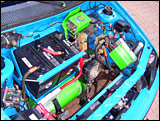 Here's a list of the components used in the conversion. Almost all were "previously enjoyed" - most of the major ones are from an old Baker electric forklift, plus some golf cart stuff thrown in for good measure.
Here's a list of the components used in the conversion. Almost all were "previously enjoyed" - most of the major ones are from an old Baker electric forklift, plus some golf cart stuff thrown in for good measure.
Host vehicles: 1992 Geo Metro + 1993 Suzuki Swift
Drivetrain: front wheel drive, with manual 5-speed transmission (clutchless)

Before conversion, both of these cars were destined for the jaws of the junkyard crusher. The 1993 Suzuki Swift was the first vehicle purchased (thus the project's nickname), but it turned out to have too much underbody corrosion to be worth saving. So we bought the 1992 Metro (in much better condition) and moved the Swift's best parts over to it. The Metro passed its safety inspection (in ICE form) with a grand total of $79 CAD invested.
Additional info about these host cars:
Electric motor: series wound DC, from Baker forklift
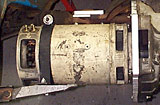
This 8 inch diameter, 50 kg / 110 lb motor (with female splined shaft) originally drove one of 3 hydraulic pumps in the Baker forklift from whence it was salvaged.
It was probably made by Otis, according to Jim Husted of Hi-Torque Electric. It's a beefy little motor, he told us, suitable for over-volting. It's got four brush pairs, and a cooling fan built in the drive end. Its biggest drawback was its internally splined shaft (see coupler section, below).
Adapter plate: custom
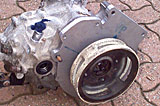
We made the adapter plate (for mounting the electric motor on the car's original transmission) from a piece of 5/8 aluminum plate. We drilled the holes for the transmission housing bolts; the critically aligned holes to mount the motor on the plate were made by a machinist friend.
Additional info:
Motor/transmission shaft coupler: adapted/custom
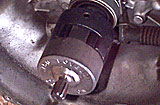
The coupler that joins the motor to the transmission was the most complex design challenge of the project because of the hydraulic pump motor's female (internal) splined shaft. We started with 3 items: the matching male shaft removed from the forklift's hydraulic pump; a Lovejoy connector with rubber "spider" bushing; the female splined clutch hub (which fits on the transmission's input shaft).
We bored out one half of the Lovejoy connector and inserted/welded the clutch hub in place; Then our machinist friend cut down the pump shaft and welded it in the other half of the Lovejoy. He added a set screw to the clutch hub half to lock it in place on the input shaft. Then, with the motor, adapter plate, coupler and transmission at his shop, he carefully aligned everything and drilled the motor mounting holes on the adapter plate.
Note: a Lovejoy coupler with a rubber bushing is best suited to a low/medium power conversion. Direct connections (clutched or taper lock) are probably better options for higher power cars.
Motor controller: Curtis 1204-412 (golf cart)
The car has had three progressively more powerful golf cart controllers since it went on the road. Currently it's using a rebuilt 400 amp 36/48 volt controller from a Club Car golf cart - great eBay find (cheap!). Much more power in reserve than the 225 amp 1204-410 we originally started out with, and somewhat better than the 300 amp one used briefly in between.
Much more info about the car's controllers:
Batteries: eight Exide GC-5, 6 volt flooded lead-acid golf cart batteries (48 volt pack)
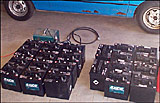
The car has had three battery packs to date:
- Originally the car started out with a scrounged up pack of VERY used Powr-Surge Trojan T-105 equivalents from the company that sold us the forklift. These were half-dead (and worse) mis-matched batteries. Good enough for testing, for building the battery racks, and for and a couple of test drives around the block, but not much more.
- A big break came when we were given a second-hand set of Exides from another EV owner. These 3-5 year-old hand-me-downs were good enough to meet our minimum range target of 16 km (10 mi.).
- On Hallowe'en 2008, we bought another set of "new to us" used Exides. These ones were approx 1-2 years old and more evenly balanced than the previous second-hand pack. Range & performance increased nicely.
Photos and more info about the car's batteries and battery racks:
Charger: Delta-Q Technologies QuiQ
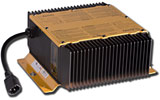
The QuiQ charger is a purpose built EV charger: 48 volts, 110/220v capable, 3-stage smart charger. Plug it in & forget it - it's wonderful! Sample recharge time: 7 hours @ 110vac after driving 26 km (16 mi).
Before the QuiQ, we were using a Vulcan EA 24/10 (24v/10A) charger meant for an industrial floor sweeper, by splitting the pack to charge in two parallel 24v strings. A bit of a hassle. 24v/10A was very slow - sometimes more than 12-14 hours depending on depth of discharge. As well, because the charger was running longer than designed (charging two strings), it got very hot, and we twice burned out a component on its circuit board.
Potentiometer (pot) box: Square-D Company (from Baker forklift)
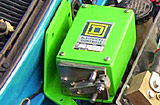
This forklift potbox is equipped with both high- & low-pedal microswitches. The actual forklift potentiometer itself couldn't be used because the Curtis controller requires a 3-wire pot, and the forklift's was a 2-wire unit. It was replaced with a Radio Shack 0-5k potentiometer connected to a small gear set to match its full rotation to the throw of the potbox arm.
Contactors: GE (from forklift)
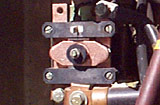
Essentially very big relays, the two contactors used in the car are GE 36/48v rated units from the forklift. They're primarily there for safety, to connect/disconnect the controller from the batteries & motor. (Controllers can fail fully shorted - IE. "full throttle" - so it's important to have a method to break the circuit should that happen.) One contactor opens/closes every time the accelerator is pressed/released (via the low-pedal microswitch in the pot box); the other is switched on/off via the ignition key switch.
Emergency disconnect: Anderson connector (forklift) / clutch pedal
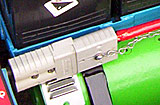
The last line of defense in the event of a short circuit is a physical/mechanical battery pack disconnect in the form of a large Anderson connector mated to the car's clutch cable. Push the pedal, and power is disconnected between the batteries and the controller/motor. (And it remains disconnected when the pedal is released.)
High voltage cabling & lugs: from forklift; also used welding cable; custom lugs

The battery interconnects, motor and controller high voltage cables are a combination of 3/0 size locomotive cable from the forklift and used 2/0 welding cable.
Lugs at the end of each cable are either original (in the case of on forklift cables) or custom made. The custom cable ends were made by flattening the cable ends, dipping them in molten solder, then finishing them flat with a grinder & file.
DC/DC converter: Vicor
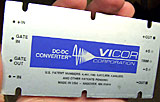
Picked up a pair of 48v/12v 100 watt modules off eBay for about $25 each. It converts the 48v of the battery pack down to approximately 14 volts to run 12v accessories like lights, signals, wipers, etc.
It's not very powerful, only putting out something like 5 amps at 12 volts, so sometimes the accessory battery needs to be topped up with a trickle charger after running the headlights and wipers. (Alternatively, I have left the ignition ON (powering the DC-DC) after driving, to top up the accessory battery.)
Instrumentation: ammeter, custom LED battery pack monitor
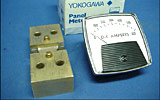
600 Amp ammeter & shunt: Bought on eBay, this is the only "new" conversion part on the car! (Still got it at a good price though!) This shows current from the batteries, and is helpful for driving efficiently (keeping amps low) or when a lot of power is needed (to decide which gear to use to get maximum current).
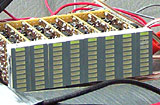
Custom LED battery pack monitor: Prior to getting this from an EV builder in the UK, a cheap digital multimeter was used to monitor voltage on only the weakest battery in the pack. The LED monitor looks like a sound system equalizer - each column shows the voltage of one battery. Monitoring voltage is important because battery damage can occur if voltage is allowed to drop too low under load.
Heater: sunshine, and a hair dryer
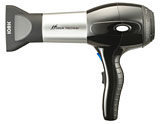
The car was used in its first winter after conversion, but not in its second. Its range & performance are significantly less (because the batteries are not insulated), so it's less practical. When heat was wanted, the car was parked in the sun to warm it up, or before particularly chilly trips a hair dryer was run inside the cabin for 20 minutes to pre-warm things.